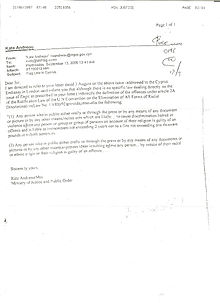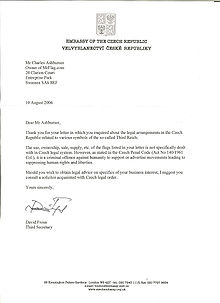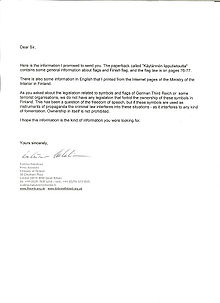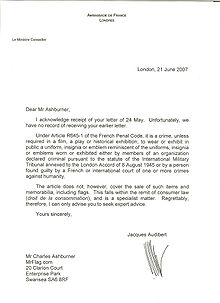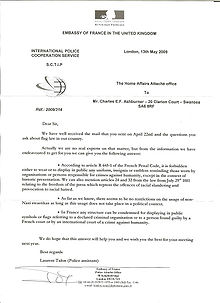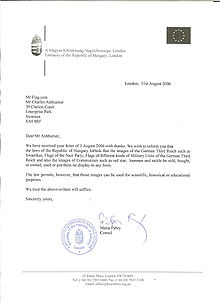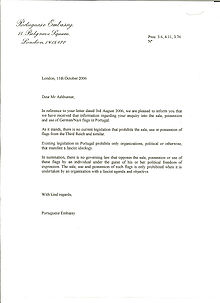- Modern use of Nazi flags
-
- See Nazi flag for a brief overview of the flags of Nazi Germany, and how such flags fit into the chronology of German vexillological history
The modern use of flags from the German Third Reich (1933-1945) is subject to legal restrictions in a number of countries.[1][2]
Whilst legal in the overwhelming majority of countries,[3][4] the display of flags associated with the Nazi regime (see: Nazi flags) is subject to restriction or an outright ban in others, particularly those with a direct involvement in the Second World War, and Germany itself.
Many Nazi flags make use of swastika symbols;[5] however, the swastika is not inherently associated with the Nationalsozialistische Deutsche Arbeiterpartei movement or of the German Third Reich or German military of 1933-1945. Use of swastikas pre-dates the German Third Reich by some 3000 years.[6][7] It is possible to display certain non-Nazi swastikas even in areas where Nazi swastikas are prohibited.
Contents
Canada
Canada has no legislation specifically restricting the ownership, display, purchase, import or export of Nazi flags. However sections 318-320 of the Criminal Code,[8] adopted by Canada's parliament in 1970 and based in large part on the 1965 Cohen Committee recommendations,[9] provide law enforcement agencies with broad scope to intervene if such flags are used to communicate hatred in a public place (particularly sections 319(1), 319(2), and 319(7).[9]
Canadian High Commission. London. 7 June 2007 [10]
...it would seem that Canada does not have restrictions on this type of flag - like there are in say Germany itself. Articulating hatred or violence against a group is a criminal code offence, but the test for inclusion in that realm is quite high. It is impossible to say from our vantage point whether this type of 'militaria' would qualify - this is where a lawyer would come in.
Cyprus
Cyprus has no legislation designed to restrict the ownership, display, purchase, import or export of Nazi flags, nor does the Criminal Code of Cyprus expressly allow for racist or other bias motives to be taken into account when sentencing.[11]
However, use of Nazi flags in a manner likely to cause discrimination, hatred, or violence may be dealt with under Cyprus' ratification of the UN Convention on the Elimination of All Forms of Racial Discrimination. This allows for the prosecution of anyone who expresses an idea (in public, using almost any medium including flags) which insults another person's race, religion or ethnicity.[12]
Ministry of Justice and Public Order. Cyprus. 13th September 2006 [12]
Although there is no specific law dealing directly on the issue of flags (as prescribed in your letter) indirectly the definition of the offences under article 2A of the Ratification Law of the U.N. Convention on the Elimination of All Forms of Racial Discrimination (Law No. 11(111)/92) provides inter-alia the following;
- Any person who in public either orally or through the press or by means of any document or picture or by any other means incites acts which are likely to cause discrimination, hatred or violence against any person or group or group of persons on account of their religion is guilty of an offence and is liable to imprisonment not exceeding 2 years or a fine not exceeding one thousand pounds or to both sentences.
- Any person who in public either orally or through the press or by any means of any documents or pictures or by any other means, expresses ideas insulting against any person... by reason of their racial or ethnic origin or their religion is guilty of an offence
Czech Republic
The Czech Republic has no legislation restricting ownership, display, purchase, import or export of Nazi flags; indeed Czech legislation makes even the banning of protests involving such flags very difficult.[13]
The police may cancel such events only once it becomes clear that protesters are inciting hate, which is deemed illegal in the Czech Republic. Legal regulation of hate crimes in the Czech Republic is contained in Act 140/1961 The Criminal Act [14] (amended by Act 175/1990).
Embassy of the Czech Republic. London. 10th August 2006[15]
The use, ownership, sale, supply, etc, of the flags listed in your letter is not specifically dealt with in Czech legal system. However, as stated in the Czech Penal Code (Act No 140/1961 Col.), it is a criminal offence against humanity to support or advertise movements leading to suppressing human rights and liberties.
Finland
Finland has no specific legislation aimed at controlling ownership, display, purchase, import or export of Nazi flags, however the Criminal Code (39/1889)[16] (especially Chapter 11 'War crimes and offences against humanity' Section 8)[16] may be applied where an offence has been directed at a person belonging to a national, racial, ethnic or other population group due to his/her membership in such a group. [17]
Embassy of Finland. London. 28th April 2009 [18]
As you asked about the legislation related to symbols and flags of the German Third Reich, we do not have any legislation that forbid the ownership of these symbols in Finland. This has been a question of the freedom of speech, but if these symbols are used as instruments of propaganda the criminal law interferes into these situations - as it interferes to any kind of fomentation. Ownership itself is not prohibited
France
In France, it is illegal to display Nazi flags, uniforms and insignia in public, unless for the purpose of a historical film, show or spectacle.[19]
Le Ministre Conseiller. Ambassade De France. London. 21st June 2007 [20]
Under Article R645-1 of the French Penal Code, it is a crime, unless required in a film, a play or historical exhibition, to wear or exhibit in public a uniform, insignia or emblem reminiscent of the uniforms, insignia or emblems worn or exhibited either by members of an organization declared criminal pursuant to the statute of the International Military Tribunal annexed to the London Accord of 8 August 1945 or by a person found guilty by a French or international court of one or more crimes against humanity.
The article does not, however, cover the sale of such items and memorabilia, including flags. This falls within the remit of consumer law (droit de la consommation), and is a specialist matter.
In April 2000 the International League against Racism and Anti-Semitism and Union des étudiants juifs de France (the Union of French Jewish Students) brought a case against Yahoo! which objected to the auctioning of Nazi memorabilia, in France, via Yahoo!'s website on the basis that it contravened Article R645-1.[21] Though a French judge did initially order Yahoo! to take measures to make it impossible for users in France to reach any Nazi memorabilia through the Yahoo! site, in December 2001 the US District Court for the Northern District of California ruled that Yahoo! would be shielded from the judgement of the French court. [22]
Embassy of France in the United Kingdom. Police Attache Office. London. 13th May 2009 [23]
- According to article R 645-1 of the French Penal Code, it is forbidden either to wear or to display in public any uniform, insignia or emblem reminding those worn by organisations or persons responsible for crimes against humanity, except in the context of historic presentation. We can also mention articles 24 and 32 from the law from July 29th 1881 relating to the freedom of the press which repress the offences of racial slandering and provocation to racial hatred.
- As far as we know, there seems to be no restrictions on the usage of non-Nazi swastikas as long as this usage does not take place in a political context.
- In France any structure can be condemned for displaying in public symbols or flags referring to a declared criminal organisation or to a person found guilty by a French court or by an international court of a crime against humanity.
Germany
Main article: Strafgesetzbuch § 86aHungary
Embassy of the Republic of Hungary. London. 31st August 2006 [24]
We wish to inform you that the laws of the Republic of Hungary forbids that the images of the German Third Reich such as Swastikas, Flags of the Nazi Party, Flags of different kinds of Military Units of the German Third Reich and also the images of Communism such as red star, hammer and sickle be sold, bought, or owned, used or put them on display in any form.
The law permits, however, that those images can be used for scientific, historical or educational purposes.Poland
Embassy of the Republic of Poland. London. 13th May 2009
- It is permitted in Poland to buy and own flags of the German Third Reich and the Nazi Party and German military units,
- In the Polish legal system there are no restrictions on the usage of non-Nazi Swastikas
Portugal
Portuguese Embassy. London. 11th October 2006.[25]
As it stands, there is no current legislation that prohibits the sale, use or possession of flags of the Third Reich and similar.
Existing legislation in Portugal prohibits only organizations, political or otherwise, that manifest a fascist ideology.
In summation, there is no governing law that opposes the sale, possession or use of these flags by an individual under the guise of his or her political freedom of expression. The sale, use and possession of such flags is only prohibited when it is undertaken by an organisation with a fascist agenda and objective.United States of America
The public display of Nazi flags in the U.S. is protected under the First Amendment to the United States Constitution. The U.S. State Department acknowledges restrictions imposed under the laws of other countries, however.
American Embassy. Information Resource Centre. London. 23rd August 2006[26]
Flags of Nazi inspiration are banned in the following countries;
- France
- Germany
- Hungary
- Israel
- Italy
See also
- Flag Institute
- All Party Parliamentary Flag Group
- Flag Institute Spring Meeting
References
- ^ "Banned flags of Nazi inspiration". Flags of the World. FOTW.net. 2001-01-12. http://www.fotw.net/flags/qt-z_ban.html#de. Retrieved 2009-06-24.
- ^ "§ 86a Verwenden von Kennzeichen verfassungswidriger Organisationen". Allgemeiner Teil. Lawww.de. 1999-01-01. http://www.lawww.de/Library/stgb/86a.htm. Retrieved 2009-06-24.
- ^ "Display of Nazi flag in the Four Seasons Arena". City Attorney’s Office. City of Great Falls, Montana. 1996-05-28. http://www.greatfallsmt.net/people_offices/city_attorney/opinions/nazi.php. Retrieved 2009-06-24.
- ^ "Ordering Nazi Flags". MrFlag.com. http://www.mrflag.com/index.php?doc=94&rev=94. Retrieved 2011-07-15.
- ^ "Third Reich 1933-1945 (Germany)". Flags of the World. FOTW.net. 2006-08-19. http://www.fotw.net/flags/de193345.html. Retrieved 2009-06-24.
- ^ "The History of the Swastika". 20th Century History. About.com. http://history1900s.about.com/cs/swastika/a/swastikahistory.htm. Retrieved 2009-06-24.
- ^ "Symbol 15:1". Online Encyclopedia of Western Signs and Ideograms. Symbols.com. http://www.symbols.com/encyclopedia/15/151.html. Retrieved 2009-06-24.
- ^ "Hate Provisions Summary". Criminal Code of Canada. Media Awareness Network. http://www.media-awareness.ca/english/resources/legislation/canadian_law/federal/criminal_code/criminal_code_hate.cfm. Retrieved 2009-06-24.
- ^ a b "Hate Propaganda". Library of Parliament. 2000-01-24. http://www.parl.gc.ca/information/library/PRBpubs/856-e.htm#a.%20Present%20Law-t. Retrieved 2009-06-24.
- ^ [|Canadian High Commission in London] (2007-06-07). "Email to Charles Ashburner of the Flag Institute". Modern Use of Nazi Flags. http://commons.wikimedia.org/wiki/File:NAZIFLAGS-Canada1.jpg. Retrieved 2009-06-24.
- ^ "Hate Crime Report Card - Cyprus". Fighting Discrimination. Human Rights First. http://www.humanrightsfirst.org/discrimination/pages.aspx?id=104. Retrieved 2009-06-23.
- ^ a b [|Ministry of Justice and Public Order] (2009-09-13). "Email to Charles Ashburner of the Flag Institute". Modern Use of Nazi Flags. http://commons.wikimedia.org/wiki/File:NAZIFLAGS-cyprus.jpg. Retrieved 2009-06-24.
- ^ "Czech court overturns ban on neo-Nazi march past city synagogue". News. Haaretz. 2008-02-01. http://www.haaretz.com/hasen/spages/950384.html. Retrieved 2009-06-24.
- ^ [|Múka, Ondřej]; [|Krutina, Miroslav]; [|Rameš, Filip]; [|Špaček, Jan] (in English/Czech) (Paper). Combating hate crime in Latvia and the Czech republic. Český helsinský výbor. ISBN 978-80-86436-22-7. http://www.helcom.cz/download/sborniky/CHV_HateCrime.pdf.
- ^ [|Embassy of the Czech Republic] (2006-08-10). "Letter to Charles Ashburner of the Flag Institute". Modern Use of Nazi Flags. http://en.wikipedia.org/wiki/File:NaziFlags-Czech-letter.jpg. Retrieved 2009-06-24.
- ^ a b "The Criminal Code of Finland (Unofficial Translation)". Legislation Database. FINLEX. 2004. http://www.finlex.fi/en/laki/kaannokset/1889/en18890039.pdf. Retrieved 2009-06-24.
- ^ "Criminal Code (39/1889)". The Criminal Code of Finland (Excerpts). Legislation Online. http://www.legislationline.org/documents/action/popup/id/4136. Retrieved 2009-06-24.
- ^ [|Embassy of Finland] (2009-04-28). "Letter to Charles Ashburner of the Flag Institute". Modern Use of Nazi Flags. http://en.wikipedia.org/wiki/File:NAZIFLAGS-Finland.jpg. Retrieved 2009-06-24.
- ^ Penal code, article R645-1; beware that this article is in the "regulations" part of the code (R articles) and that some editions may include only the "statutes" part (L articles).
- ^ [|Le Ministre Conseiller. Ambassade De France.] (2007-06-21). "Letter to Charles Ashburner of the Flag Institute". Modern Use of Nazi Flags. http://en.wikipedia.org/wiki/File:NaziFlags-France2-letter.jpg. Retrieved 2009-06-24.
- ^ "LICRA v. Yahoo! Inc., No. RG 00/05308". Tribunal de Grande Instance de Paris. American Society of International Law. 2000-11-20. http://www.asil.org/ilib0333.cfm#03. Retrieved 2009-06-26.
- ^ [|Klosek, Jacqueline] (Hardcover). The Legal Guide To E-Business. Praeger Publishers. ISBN 978-1567204032. http://www.amazon.com/Legal-Guide-E-Business-Jacqueline-Klosek/dp/1567204031.
- ^ [|Embassy of France in the UK] (2009-05-13). "Letter to Charles Ashburner of the Flag Institute". Modern Use of Nazi Flags. http://en.wikipedia.org/wiki/File:NaziFlags-France1-letter.jpg. Retrieved 2009-06-24.
- ^ [|Embassy of the Republic of Hungary] (2006-08-31). "Letter to Charles Ashburner of the Flag Institute". Modern Use of Nazi Flags. http://en.wikipedia.org/wiki/File:NaziFlags-Hungary-letter.jpg. Retrieved 2009-06-24.
- ^ [|Portuguese Embassy, London.] (2006-10-11). "Letter to Charles Ashburner of the Flag Institute". Modern Use of Nazi Flags. http://en.wikipedia.org/wiki/File:NaziFlags-Portugal-letter.jpg. Retrieved 2009-06-24.
- ^ [|US Embassy, London] (2006-08-23). "Handwritten card to Charles Ashburner of the Flag Institute". Modern Use of Nazi Flags. http://commons.wikimedia.org/wiki/File:NAZIFLAGS-USAletter1.jpg. Retrieved 2009-06-24.
External links
- "Holocaust Denial Laws and Other Legislation Criminalizing Promotion of Nazism". International Institute for Holocaust Studies. http://www1.yadvashem.org/about_HOLocaust/holocaust_antisemitism/Bazyler_doc.pdf. Retrieved 2009-06-24.[dead link]
- "Combating the resurrection of nazi ideology". Council of Europe Parliamentary Assembly. http://assembly.coe.int/Main.asp?link=/Documents/WorkingDocs/Doc05/EDOC10766.htm. Retrieved 2009-06-24.
Categories:- National flags
- Nazism
Wikimedia Foundation. 2010.




